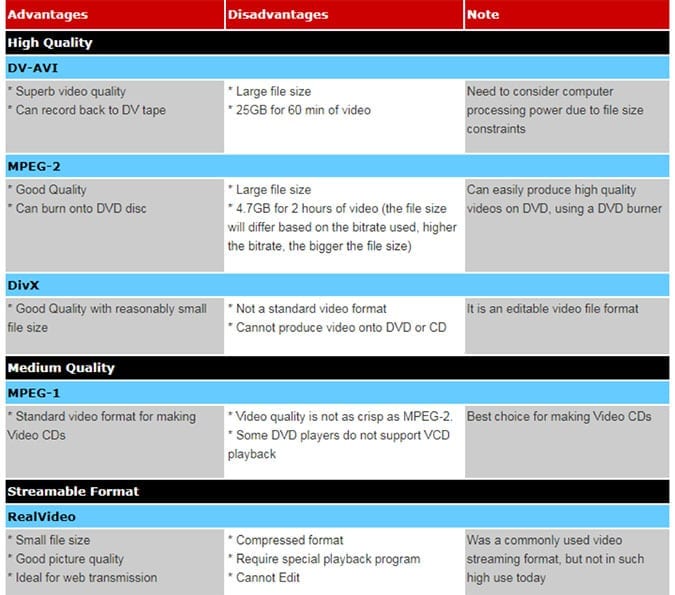Ever get confused with the various video formats out there? Ever wonder what the best codecs are? Do you ever spend time deliberating over what video format to render a final deliverable to?
All of these are questions that anyone working with video asks themselves.
Video file formats are basically the type of computer file that a video gets stored as. The modern-day videographer has a variety of video file formats in which they can save their work.
Different video file formats do different things and choosing the right video file format for your needs can be tricky.
In this post, were going to give you a brief rundown on some of the different kinds of video formats that are out there and their pros and cons for you as a video producer.
Codec And Container
The first thing that you need to know about the different video file formats is that they are all made up of two parts called the codec and the container.
- the codec.
- the container.
A codec basically compresses and decompresses the data that is contained in a video file. Videos need to be compressed because most are too large and, if uncompressed, their size will make them difficult to download or to play. The different codecs work for different types of video and they also determine which media players can play back a video.
Common examples of codecs are:
- FFmpeg – which works with formats such as MPEG-2 (plays DVDs) and MPEG-4 (plays videos on Apple devices).
- DivX – which works with certain MPEG-4 files.
- XviD – an DivX’s open source version.
- X264 – which compresses H.264 videos (HD videos).
A container is basically a collection of files that stores the information about the video file. It is a combination of audio and video data in one file that allows for simultaneous play-back.
The different file video formats usually take the name of their container. When choosing a video format, you’re basically choosing a container (codec included) that will best allow you to save and playback your work.
Different Containers For Different Uses
Let’s take a closer look at some of the more common video file formats that are out there. This also gives us an opportunity to go through some of their different pros and cons.
1. AVI
This stands for Audio Video Interleave.
The AVI was developed by Microsoft and released in November 1992. The goal was to enable Windows users to play videos on their computers.
It is one of the oldest video formats that is still in use today.
AVI files can be run on Windows, Mac, and Linux OS. They are also supported by most popular web browsers.
2. FLV
This stands for Flash Video Format. FLV contains data files that have been encoded by using Adobe Flash software. They use codecs that follow the Sorenson Spark of the VP6 compression formats.
FLV files were created to be played using the Adobe Flash player. They can also be viewed with web browser plugins or by using third party programs.
FLV is still one of the most popular video file formats for online video viewing. Online video sharing sites, stream videos using Flash and most of the popular web browsers still come with Adobe Flash player installed. If not, it is easily downloaded.
FLV is also the format to which many video-sharing sites will automatically convert their videos into.
The reason for FLV’s popularity among online platforms is, files in this format remain high-quality after compression into a smaller file size.
Because of this, videos in FLV format will load on the web quickly, without requiring viewers to use up a lot of bandwidth. Thus saving copious amounts of time for online viewers.
Some notable sites that use the FLV format are YouTube, VEVO, Yahoo Video, and Hulu.
3. WMV
This file format stands for Windows Media Video. The WMV video format was developed by Microsoft for web streaming applications, but it now also caters to more specialized content.
As it was developed by Microsoft, it is compatible with the Windows Media Player, which is the default video player that comes with all versions of Microsoft’s Windows OS. Free WMV compatible players are also available for Mac OS.
The sizes of WMV files decrease significantly when compressed, making then some of the smallest video files available over the web.
Because of their small file sizes, this is one of the only video file formats that can easily be uploaded and shared via e-mail. The downside of WMV is, because it is so compressed, the video quality is poor.
If your video client wants a preview video sent quickly, WMV would be an okay format to use. Just make sure to inform your client that the poor video quality will be improved for the final product.
4. MOV
This file format is also known as the Apple QuickTime Movie format. Or just, simply, QuickTime.
Developed by Apple, QuickTime is their answer to Microsoft’s WMV. The QuickTime format allows Mac users to easily save, share and view videos on their device. It’s also often used on the web.
The default program for viewing MOV files is the Apple QuickTime Player, which is automatically available with Apple OS. However, there is a free version of QuickTime Player that is available for use with Windows OS.
MOV files are bigger then WMV files and are better looking and of higher quality.
5. MP4
This file format is an abbreviation for MPEG-4 which stands for Moving Pictures Expert Group 4.
The Motion Pictures Expert Group developed this format. This group is also responsible for setting the industry standards for digital audio and video.
A file saved in the MP4 format has separate compressions for both the audio and the video tracks. The video track is compressed using MPEG-4 or H.264 video encoding. The audio track is compressed with AAC compression.
The MP4 video file format was first introduced in 1998. Till today, the MPEG-4 video is commonly used for video sharing via the web. Its popularity is due to the fact that the file sizes are relatively small but the video retains its high quality.
The MP4 video standard is compatible with both online and mobile browsers.
Those who use Apple’s awesome video editing platform, Final Cut Pro, will be very familiar with exporting video files in MP4 format.
https://youtube.com/watch?v=owe3561aOAg
6. AVCHD
This stands for Advanced Video Coding, High Definition. This video file format was developed by a collaboration of Sony and Panasonic. The AVCHD format was designed to create videos that are suited for these two tech giant’s lines of digital camcorders.
The AVCHD format is file-based. This means that it is meant to be stored and played back using storage devices such as disks, compact flash drives or with SD cards. There are standard definition and high definition video quality variants.
What Is The Right Format For You?
In the end, the right type of video file format for you to use will mostly depend on how you intend the video to be viewed.
If the video is meant to be viewed online, it’s best that it be in a format that can compress the file. This is so that it can be viewed quickly online without taking up too much bandwidth.
If the video is meant to be watched on a TV, you will want to use a format that has good video quality but remains at a file size that is suitable for burning onto a DVD/exporting to USB. Or, for professional use, a format that is ‘broadcast safe.’
Liza Brown at Filmora recommends choosing what video format to use based on the platform that you intend the video to be shared and watched on. Check out the following table:
| Platform | Video Format |
| Online Video (YouTube) | Best: MP4, FLV, MOV, AVI
Okay: MPEG, WMV, SWF |
| HD TV/Computer | MOV, AVI, MKV |
| Burned on a DVD | MPEG-2 |
| Websites | WEBM, HTML5 |
Over at Cyberlink , you can find another handy chart on the best video formats to use. They list the types of video formats according to video quality. They then show you the pros and cons of each format.
Check out the chart here:
Remember, there is always the option to create and save a video file in multiple formats.
There are a number of free and low-cost video file conversion utilities that can convert video files from one format to another.
It might be best to ask your clients about the ways they want their video files viewable and present them with copies of the videos in several different formats.
It is important, however, to always keep a copy of the original video file in the highest possible quality format. When you transfer formats, you will be re-compressing the files and re-compression can cause degradation.
Video Formats — In Conclusion
Remember that, as video making and viewing technology marches on, so too will video file formats.
New containers and codecs that will allow for larger files to be delivered quickly will continue to evolve and chances are they will never really be a ‘final’ best video format to use.
The best way to deliver quality videos to your clients will be to always keep in mind what the client wants and how they intend to use the videos. Remember, whatever the need and whatever the useage type, you can deliver. There’s a video format for any (and every) situation.
We hope you’ve found this article on video formats insightful. What’s your favorite video file format for delivering to clients? Let us know in the comments below here.
Matt Crawford
Related posts
20 Comments
Leave a Reply Cancel reply
This site uses Akismet to reduce spam. Learn how your comment data is processed.











this was a useful breakdown of the various video formats — always get stuck with these.
Glad to be of assistance, Randy.
I never paid attention to about types of video formats. Seems there are many. Thanks for the article.
No probs, Charles.
I love learning about new video formats! This blog post was very informative.
Awesome, Mitchell.
I love learning about new video formats! This article was very informative.
Thanks, Greg.
Great article! I’m glad to see a detailed explanation of the different video formats and their uses. As a video producer, I know how important it is to choose the right format for my content. The section on the 6 file formats you need to know was especially helpful. Can’t wait to share this knowledge with my team!
Thanks for taking the time
Great article! It’s really helpful to have a comprehensive guide to video formats in one place. I’m glad you included information on the pros and cons of each format, as well as when to use each one. As a regular blog reader, I found this post to be informative and easy to understand. Keep up the good work!
Thank you
This was a great post! I’ve been struggling to understand the different video formats and their uses. Now I feel confident in choosing the right format for my next project. Thank you for breaking it down so simply and providing real-world examples.
Thanks! What’s your take on this topic?
Thanks for this comprehensive guide to video formats! I’ve been struggling to understand the differences between formats and when to use them, but this post has clarified everything for me. The 6 file formats you listed are exactly the ones I’ve been confused about, and I’m now confident I can choose the right one for my next project. Keep up the great work!
Great comment! Do you have any experiences to share on this?
Thanks for this informative post! It’s really helpful to understand the different video formats and when to use each one. I especially found the section on file sizes and compression rates useful, as I’ve been trying to figure out why my video files were taking up so much space on my hard drive. Can you do a follow-up post on video editing software recommendations?
Interesting take! Appreciate the input.
I never realized there were so many file formats out there! Thank you for breaking it down in such an easy-to-understand way. I’m definitely going to make sure to use the right format for my next video project.
That’s a great point! Thanks for sharing your perspective.